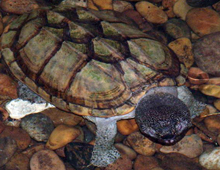Description: Commonly referred to as “stinkpot” turtles, the Mexican giant musk turtle is the largest of all musk turtles. It gets its name from the “musky” smell it excretes from glands at the rear of the shell. The carapace is typically arched slightly and the skin has much the same color as the shell, usually a drab olive or gray-brown. They have three longitudinal lines running the length of the shell. They also have a very large head and, unlike most other turtles, cannot retract the head into the shell.
Size: They are known to reach sizes up to 15 inches (38 cm.)
Behavior: Mexican musk turtles are spend quite a bit of time hunting for food. They usually hunt in the water, spending about 80-90% of their time in slow moving bodies of fresh water.
Diet: These voracious feeders will typically eat almost anything. Their natural diet includes fish, snails, frogs, worms and occasionally smaller turtles.
Senses: The shell is supplied with blood vessels and nerves so like other turtles it can feel when being touched. The Giant mexican musk turtle has a well developed sense of vision that they use to help catch their prey.
Communication: The males will communicate through body language and “love bites” when its time to begin breeding.
Reproduction: Giant mexican musk turtles tend to breed in late fall and winter. Courtship and breeding is typical of other musk turtles with much chasing and biting from both sexes. Copulation can last for several minutes to nearly an hour and the turtles will continue to breed repeatedly throughout the day. The females generally lay a clutch of about 12 elongated, brittle shelled eggs withing 30-60 days of breeding. Occasionally the female will lay two or even three cluthes per season.
Habitat/range: Staurotypus triporcatus are usually found in the slow moving freshwater rivers of Mexico, Belize, Guatemala, Honduras and Venezuela.
Status: Listed as Near Threatened on IUCN Red List.



